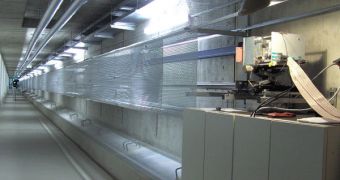Measuring dimensions is something that comes natural to a laser, especially if we are talking about small distances. Inside a room, a good laser system can determine everything there is to determine in a manner of seconds. But the main issue plaguing these systems has until now been the fact that they did not operate very well on the exterior. However, all that is about to change now, as German researchers from the Fraunhofer Institute for Physical Measurement Techniques IPM, in Freiburg, present a laser capable of measuring distances up to ten times faster than any of its predecessors, PhysOrg reports.
The thing that allows a laser to measure distances is its speed. If the beams move fast, then they can provide precise measurements of the targets scientists aim them at. In the case of external targets, this becomes a lot more difficult to do, so many devices using stimulated light have thus far failed to raise up to the challenge. Usually, for commercial and civil applications, scientists use lasers mounted on cars to perform measurements on buildings, homes, overpasses, bridges and other such structures.
When a street is built, and an overpass is constructed on top of it, it's essential for authorities to know what trucks will be able to fit under the bridge. Houses in a new neighborhood also have to be positioned in such a manner that they allow for the passing of an oversized vehicle, if this is necessary. All of these measurements are conducted with specialized cars. The lasers on these vehicles work on the same basic principle – they bounce light on objects, and wait for it to come back. The time it takes for the beam to return gives the distance. The data is then coupled with GPS information to create a map of the area.
The main drawback this system has is that it moves extremely slowly. The car carrying the equipment needs to crawl on the street, so that sufficient points are captured on the laser's computer to construct an accurate representation of the street or bridge. This also means that the device cannot be installed on helicopters and airplanes, where they would have to construct accurate representations of the terrain below in real time. The slow speed of the beams would spell certain doom for any pilot.
But the German research team has managed to solve all these problems, by creating a laser capable of reporting the distance it lies from an object up to 80 meters away. The best part is that it manages to do that in just two microseconds, or even faster, depending on conditions. “We have developed new electronic circuits and special software to process the data. In addition we have optimized the laser pulse rate. We can either measure ten times faster or retain the scanner speed but analyze ten times as many points of an object – for instance from an airplane,” IPM Project Manager Dr. Ilia Bourovoi says.

 14 DAY TRIAL //
14 DAY TRIAL //